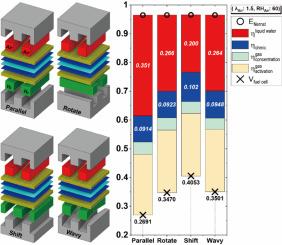Effects of flow field combination in proton exchange membrane fuel cells on water management
IF 5.5
3区 材料科学
Q1 ELECTROCHEMISTRY
引用次数: 0
Abstract
The gas diffusion layer (GDL), a key component of proton exchange membrane fuel cells (PEMFCs), is unevenly compressed by the ribs of both the anode and cathode bipolar plates (BP). The electrical and transport characteristics of the GDL vary with the compression ratio, which influences the supply of reactants, discharge products, and the movement of electrons. This study analyzes the performance differences and overpotentials based on the flow-field combinations. The four combinations, named after the anode flow field, are parallel, rotate, shift, and wavy. The overpotentials of the fuel cell are analyzed using current-voltage curves, electrochemical impedance spectroscopy, and the current interruption method under three operating conditions with different stoichiometric ratios and relative humidity. Through experiments, we decompose the fuel cell overpotential into activation overpotential (ignoring liquid water), ohmic overpotential, concentration overpotential (ignoring liquid water), and liquid water overpotential. The shift combination exhibits excellent performance owing to its high water-discharge effect despite its high ohmic overpotential, whereas the parallel combination exhibits the lowest performance due to flooding. Consequently, by changing the flow field combination under the same operating conditions, the performance improves by up to 33 %.


质子交换膜燃料电池流场组合对水管理的影响
气体扩散层(GDL)是质子交换膜燃料电池(pemfc)的关键组成部分,它受到阳极和阴极双极板(BP)肋的不均匀压缩。GDL的电学和输运特性随压缩比的变化而变化,从而影响反应物的供应、放电产物和电子的运动。本文分析了基于流场组合的性能差异和过电位。这四种组合以阳极流场命名,分别是平行、旋转、移位和波浪。在不同的化学计量比和相对湿度条件下,采用电流-电压曲线、电化学阻抗谱和电流中断法分析了燃料电池的过电位。通过实验,我们将燃料电池过电位分解为活化过电位(忽略液态水)、欧姆过电位、浓度过电位(忽略液态水)、液态水过电位。移位组合尽管具有高欧姆过电位,但由于其高排水效果而表现出优异的性能,而并联组合由于水淹而表现出最低的性能。因此,在相同工作条件下,通过改变流场组合,性能可提高33%。
本文章由计算机程序翻译,如有差异,请以英文原文为准。
求助全文
约1分钟内获得全文
求助全文
来源期刊

Electrochimica Acta
工程技术-电化学
CiteScore
11.30
自引率
6.10%
发文量
1634
审稿时长
41 days
期刊介绍:
Electrochimica Acta is an international journal. It is intended for the publication of both original work and reviews in the field of electrochemistry. Electrochemistry should be interpreted to mean any of the research fields covered by the Divisions of the International Society of Electrochemistry listed below, as well as emerging scientific domains covered by ISE New Topics Committee.
 求助内容:
求助内容: 应助结果提醒方式:
应助结果提醒方式:


